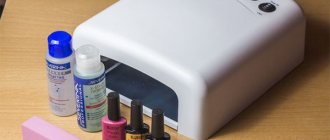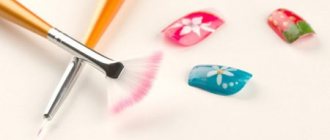Gel paint with or without a sticky layer, which one is needed?
Gel paint is available in two types:
- with a sticky dispersion layer that remains after exposure to ultraviolet rays - this option is necessary for casting techniques, creating a sand-effect surface and other designs where elements need to be imprinted and fixed;
- without a sticky layer - this option is ideal for artistic painting and for creating different types of French and lunar manicure.
It is impossible to say which variety is better; it is better for the master to have both types of paints in stock in order to be able to realize any design ideas.
How to paint with gel paints on gel polish correctly?
The texture and richness of gel paints allow you to create any designs with their help, both on extended or coated gel polish, and on natural nails. In the case of gel polish, you must follow the following algorithm:
- At the first stage, the surface is prepared. Gel polish of the desired color is applied to the nail plate in 2 layers, each of which is polymerized in a lamp. If there is a residual dispersion (sticky) layer, it must be removed.
- Now you can start drawing. To do this, dip a brush or dot stick into the selected shade of paint and create the desired design on a gel polish base.
- In the case of a complex multi-color pattern, it is better to dry each element in a lamp separately so that they do not become smeared during work. If something doesn’t work out, then it can be corrected only before polymerization; after that, the unsuccessful drawing can only be filed off.
- When the drawing is ready, it can be coated with topcoat if necessary and also polymerized.
Is it necessary to cover the gel paint with a topcoat or is it not necessary?
The need to coat the gel paint with a top coat depends on the design for which it was used. So, different options are possible:
- drawing thin small lines or simple patterns - does not require mandatory coating;
- flat large patterns and designs - covering with a topcoat is necessary for their preservation;
- sand effect - no coating required, etc.
The properties of the gel base of the material are such that after polymerization it may well remain without a protective layer, but in some cases overlapping is necessary to preserve the design.
How to choose a base for gel polish?
Rating of the best nail primers
| Category | Place | Name |
| gel bases - premium varnish | 1 | Base for gel polish NANLAC Gum |
| 2 | Base for gel polish Beautix UV Base | |
| 3 | Base for gel polish In'Garden Rubber Ideal Nails | |
| 4 | Base for gel polish Kodi Rubber Base |
What is a color base
First, a little terminology.
Gel polish base is the first layer of a gel nail coating system. The purpose of the layer is to ensure adhesion of all other materials to the nail for long-term wear.
Initially, bases for gel polish were only transparent and differed in hardness and were divided into hard, elastic, medium and soft. A little later, camouflage bases appeared.
Unlike regular ones, camouflage ones had a light color and made it possible to cover the nails with a natural shade - pinkish, peach, milky. Camouflage was used to create a French manicure or just a calm cover, for example, for those who adhere to the dress code in the office.
2020 was a turning point for camouflages - in addition to nude, milky and pink shades, colored bases appeared. The TopShopNails brand was the first to notice unusual coatings, and later other manufacturers followed suit - now more than a dozen different companies produce color bases from translucent to dense neon.
View this post on Instagram
Post by Gel Polish (@luiphilipp_gel)
As with regular camouflages or clear bases, colored ones can be:
- Hard or hard;
- Medium hardness;
- Soft or fragile;
- Elastic.
You need to select a specific hardness based on the characteristics of the nail plate:
- For soft, bendable nail plates, a rubber base is suitable. Due to its density, it will help fix the nail, and the plastic formula will not allow the coating to crack;
- For short, dense nails, use a medium-hard colored base;
- If the natural nail plate is long, the elastic base will not work - it may sag in the stress zone precisely because of its plasticity. If the free edge is long, choose a medium-hard colored base.
Base coats come in different colors and consistencies – thick, medium or liquid. A colored nail base replaces 2 stages of coating at once - base and color. The same thing was done using regular camouflages, but colored bases added variety to the palette and now an express manicure can be done in either a green or blue shade.
View this post on Instagram
Publication from











